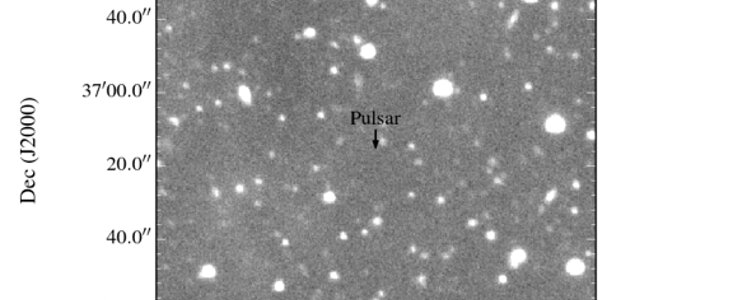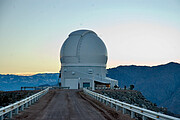NOAO: The Coolest Known White Dwarf: A Diamond in the Sky?
23 Junio 2014
“Up above the world so high, like a diamond in the sky…” A team of astronomers, using multiple telescopes, has identified the coolest, faintest white dwarf star known. White dwarfs are the extremely dense end states of stars like our sun: after their nuclear fuel is exhausted, they collapse from the size of a star (about 1,000,000 miles across) to the size of the Earth (7,000 miles across). This white dwarf, located in the constellation Aquarius, is so cool that its carbon has crystallized—in other words, it’s like a diamond, with a mass similar to that of our sun.
The path to this discovery began when Dr. Jason Boyles, then a graduate student at West Virginia University, identified what astronomers refer to as a millisecond pulsar in this location. Pulsars are spinning neutron stars—the collapsed end state of a star many times more massive than our sun, but only about 20 miles across. Known as PSR J2222-0137, which simply identifies its position in the sky, this pulsar is spinning over 30 times a second. Its orientation is such that as it spins, a beam from its magnetic pole sweeps repeatedly past the earth, giving rise to regular blips of radio waves. (The pulsar is detected only in radio waves, not in visible light.) The observations also revealed that this pulsar is gravitationally bound to a companion star: the two orbit around each other every 2.45 days. It is this companion object that appears to be either another neutron star or, more likely, a remarkably cool white dwarf.
The distance to the pulsar was already known from parallax measurements made by Dr. Adam Deller at the Netherlands Institute for Radio Astronomy. Parallax, which utilizes the motion of the earth around the sun, is the gold standard for determining distances to astronomical objects. At only about 900 light-years away, it is one of the closest neutron stars known. Knowing the distance is crucial for calculating the intrinsic brightness, and therefore the temperature, of the stellar remnants. And as the lead author of this paper, Prof. David Kaplan, remarked, “These same observations also pinpointed the position of the pulsar extremely precisely. That’s how we can be so certain that all of the other stars in the field are not the pulsar. You could say that we know the position of the pulsar to better than one pixel.” This became very important when they searched for the optical evidence of the white dwarf companion.
It is also critical to know the mass of each component of the binary system. To determine these, the team applied Einstein’s theory of general relativity, which first predicted that light (or radio waves) slows in the gravitational field of a massive object. From the periodic delay of the radio signal as the radio beam from the pulsar skimmed over the surface of the companion, combined with the law of gravity, the team could determine the orientation of the orbit of the two stars in space, as well as their individual masses. They found the pulsar has a mass of 1.2 times that of the sun and the companion has a mass of 1.05 times that of the sun.
Next, they searched for visible and infrared evidence of the companion, using the Southern Astrophysical Research (SOAR) telescope in Chile and the Keck telescope in Hawaii. With their knowledge of the distance of the pulsar, the team was able to calculate how intrinsically faint the companion object is. But nothing could be seen at the position of the pulsar and its white dwarf companion! As Bart Dunlap, a graduate student at the University of North Carolina at Chapel Hill and one of the team members, said, “Because of the radio observations, we know exactly where to look, so we pointed SOAR there and collected light for two and a half hours. Our final image should show us a companion 100 times fainter than any other white dwarf orbiting a neutron star and about 10 times fainter than any known white dwarf, but we don’t see a thing. If there’s a white dwarf there, and there almost certainly is, it must be extremely cold.” Figure 1 shows the region around the pulsar: the position of the pulsar in this image is known to within one pixel, or about 1/400 the size of this image.
Such a cool, collapsed star is calculated to be composed of mostly carbon and oxygen, which means it might be largely crystallized carbon—a big diamond! While such cool white dwarfs are theoretically not that rare, it was the fortuitous combination of circumstances that led the team to be able to identify this one. This star was probably born very early in the history of the Milky Way, and it has gradually been getting cooler and fainter ever since.
The paper, with lead author David Kaplan, University of Wisconsin–Milwaukee, has been accepted for publication in the Astrophysical Journal.
Más Información
The SOAR Telescope is a joint project of Conselho Nacional de Pesquisas Científicas e Tecnológicas CNPq-Brazil, The University of North Carolina at Chapel Hill, Michigan State University, and the National Optical Astronomy Observatory, a division of the National Optical Astronomy Observatory, operated by the Association of Universities for Research in Astronomy (AURA) under a cooperative agreement with the National Science Foundation
Contactos
Prof. David Kaplan
Asst. Professor Dept. of Physics, UW-Milwaukee
Tel: +1-414-229-4971
Cel: +1-414-229-5589
Correo electrónico: kaplan@uwm.edu
Mr. Bart Dunlap
Dept. of Physics and Astronomy University of North Carolina at Chapel Hill
Correo electrónico: bhdunlap@physics.unc.edu
About the Release
| Release No.: | noao1403 |
| Legacy ID: | NOAO 14-04 |
| Nombre: | PSR J2222-0137 |
| Facility: | SOAR Telescope |
| Instruments: | Goodman |
| Science data: | 2014ApJ...789..119K |




